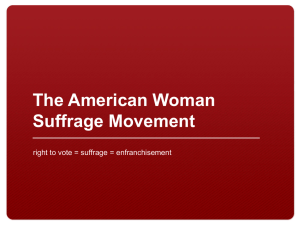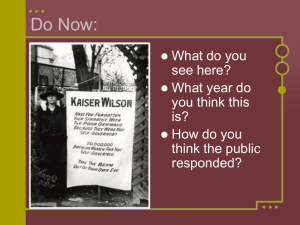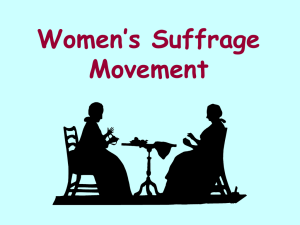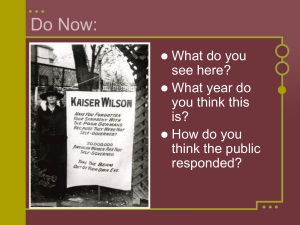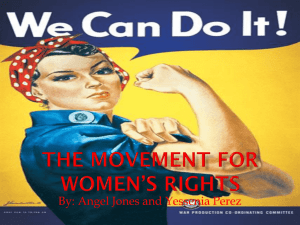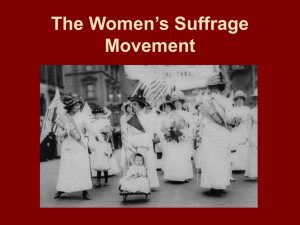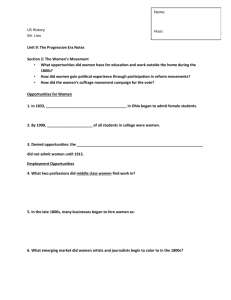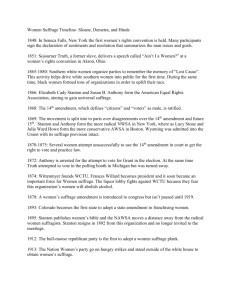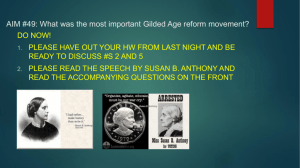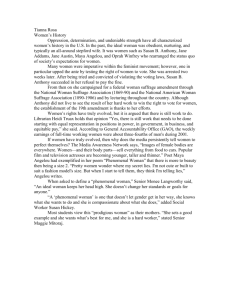File - FHS US History
advertisement
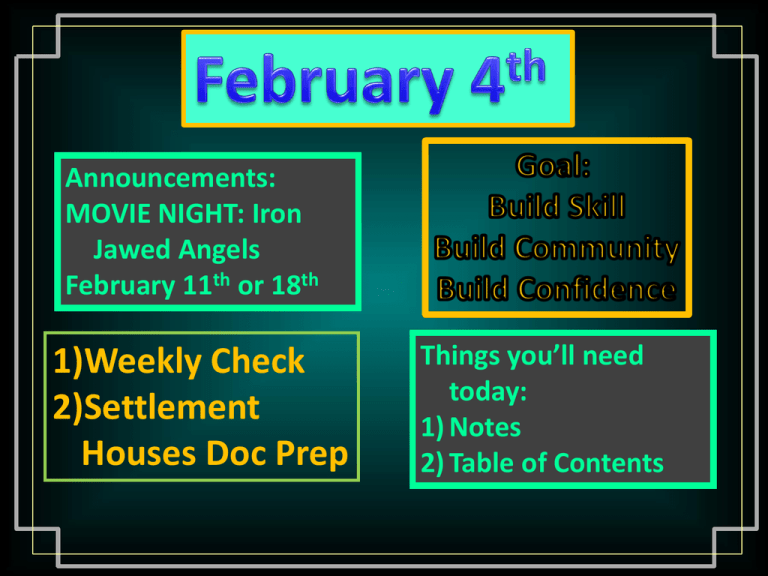
Announcements: MOVIE NIGHT: Iron Jawed Angels February 11th or 18th 1)Weekly Check 2)Settlement Houses Doc Prep Things you’ll need today: 1) Notes 2) Table of Contents Date Points Title Description of historical content Type of work 1) 1-13 10 Lecture Industrialism: Opportunity or Abuse? USA Era by Era Craig USA One era at a Time and Industry Opportunity or Abuse? 2) 1-13 10 Opportunity or Abuse T-chart Compare the events of the industrial age and identify whether they created opportunities or abused 3) 1-14 10 Lecture Industrialism Opp or Abuse (con’t.) 4) 1-15 10 Industrialism Movie Clips Watch 5 clips, take notes 5) 1-16 10 Crash Course: Industrialism Crash Course with John Green and Intro to Captains and Robber Barons Lecture To use with Mini-Q 6) 1-20 10 American Heroes Chart Quote Interp (on paper, not graded)+ Use the History’s Heroes site to identify 5 of your heroes and why you chose them 7) 1-20 + 21 30 Andrew Carnegie Mini-Q Packet HAD: Background Essay (10) HAD: Documents (10) 8) 1-22 p5 1-22 p4 10 Document Analysis Forms Done with teammates or individually, depending on homework completion One full analysis, other side= up to 4 short analysis 9) 1-23 10 DBQ Outline Form Due MONDAY. If incomplete, an essay will be assigned. 10) 1-26 10 Chapter 6,3 with supplement Use movie clips and Google Date Points Title Description of historical content Type of work 11) 1-27 20 Unions and Strikes Chart SEE MY PHONE FOR DIAGRAMS (10) Include white board illustration of one of the Unions or Strikes Quick Present 12) 1-28 10 America’s Immigration Movie on Weebly Explained Simply 13) 1-28 10 Notes Chapter 7,3 Cornell Notes from textbook 14) 1-29 20 Immigration/Gilded Lecture/Crash Course T-chart 15) 1-29 10 HW: Ch 7,3 Quiz 16) 1-30 20 Political Bosses Muckraker and political bosses PSD’s Steffans/Plunkitt Docs 17) 2-2 10 Chapter 9,1 18) 19) Sub. work The American Woman Suffrage Movement right to vote = suffrage = enfranchisement Do Now • What do you see here? • Around what year do you think this photograph was taken? • How do you think the public responded? 5 Seneca Falls, New York 1848 • In the early 1800s, many women were involved in the abolition (anti-slavery) and temperance (no alcohol) movements • A group of women and men gathered at a conference in Seneca Falls, NY in 1848 • This conference was led by Elizabeth Cady Stanton and Lucretia Mott • Conference attendees wrote the Declaration of Sentiments 6 Fifteenth Amendment, 1871 • Granted African-American men the right to vote • Disappointed many women who thought African-American men and women would be enfranchised together • African Americans were split over whether men should get vote before women 7 Frederick Douglass, 1869 “When women, because they are women . . . are dragged from their houses and hung upon lamp posts; when their children are torn from their arms, and their brains dashed upon the pavement . . . Then they will have an urgency to obtain the ballot equal to our own.” But was this not true for black women? “Yes, yes, yes. It is true for the black woman but not because she is a woman but because she is black!” 8 Sojourner Truth, 1869 Sojourner Truth, 1864 “There is a great stir about colored men getting their rights, but not a word about the colored women … And if colored men get their rights, and not colored women theirs, you see the colored men will be masters over the women, and it will be just as bad as it was before.” 9 Before 1910 • National American Woman Suffrage Association (NAWSA) • Big leaders: Susan B. Anthony, Elizabeth Cady Stanton • Two big strategies: • Try to win suffrage state by state • Try to pass a Constitutional Amendment (but this would need to be ratified by 36 states – or three-fourths) 10 Susan B. Anthony Susan B. Anthony In the late 1800s, Susan B. Anthony tried several times to introduce an Amendment bill for women’s suffrage, but it was always killed in the Senate. 11 Anti-suffragists Those who opposed extending the right to vote to women were called anti-suffragists. Many anti’s were women. Political cartoon mocking anti’s: “O Save Us, Senators, from Ourselves!” 12 Beliefs of Anti-Suffragists • Women were high-strung, irrational, and emotional • Women were not smart or educated enough • Women should stay at home • Women were too physically frail; they would get tired just walking to the polling station • Women would become masculine if they voted 13 Map of Women’s Suffrage Before 1920 14 The Next Generation • Elizabeth Cady Stanton died in 1902 • Susan B. Anthony died in 1906 • But in the early 1900s many young, middle-class women were going to college and joining the suffrage movement • Many working-class women also joined the cause, hoping the right to vote would help improve working conditions 15 Safe or Sorry? Carrie Chapman Catt led the National American Woman Suffrage Association. She believed in: • Careful state-by-state strategy • Supporting President Wilson even though he didn’t outright support suffrage because Democrats were a safer bet than Republicans • Acting ladylike so as not to embarrass the movement 16 National Woman’s Party Alice Paul led the NWP and believed in more aggressive strategies: • Focused on passing a Constitutional Amendment • Adopted un-ladylike strategies from British suffragettes (e.g. heckling politicians, picketing) • Refused to support President Wilson if he wouldn’t support woman suffrage • NWP members were arrested for picketing in front of the White House. They were put in jail, went on a hunger strike, and were force-fed. 17 19th Amendment, 1920 Tennessee was the 36th state to ratify, and it passed by only 1 vote. The right of citizens of the United States to vote shall not be denied or abridged by the United States or by any State on account of sex. Congress shall have power to enforce this article by appropriate legislation. 18
